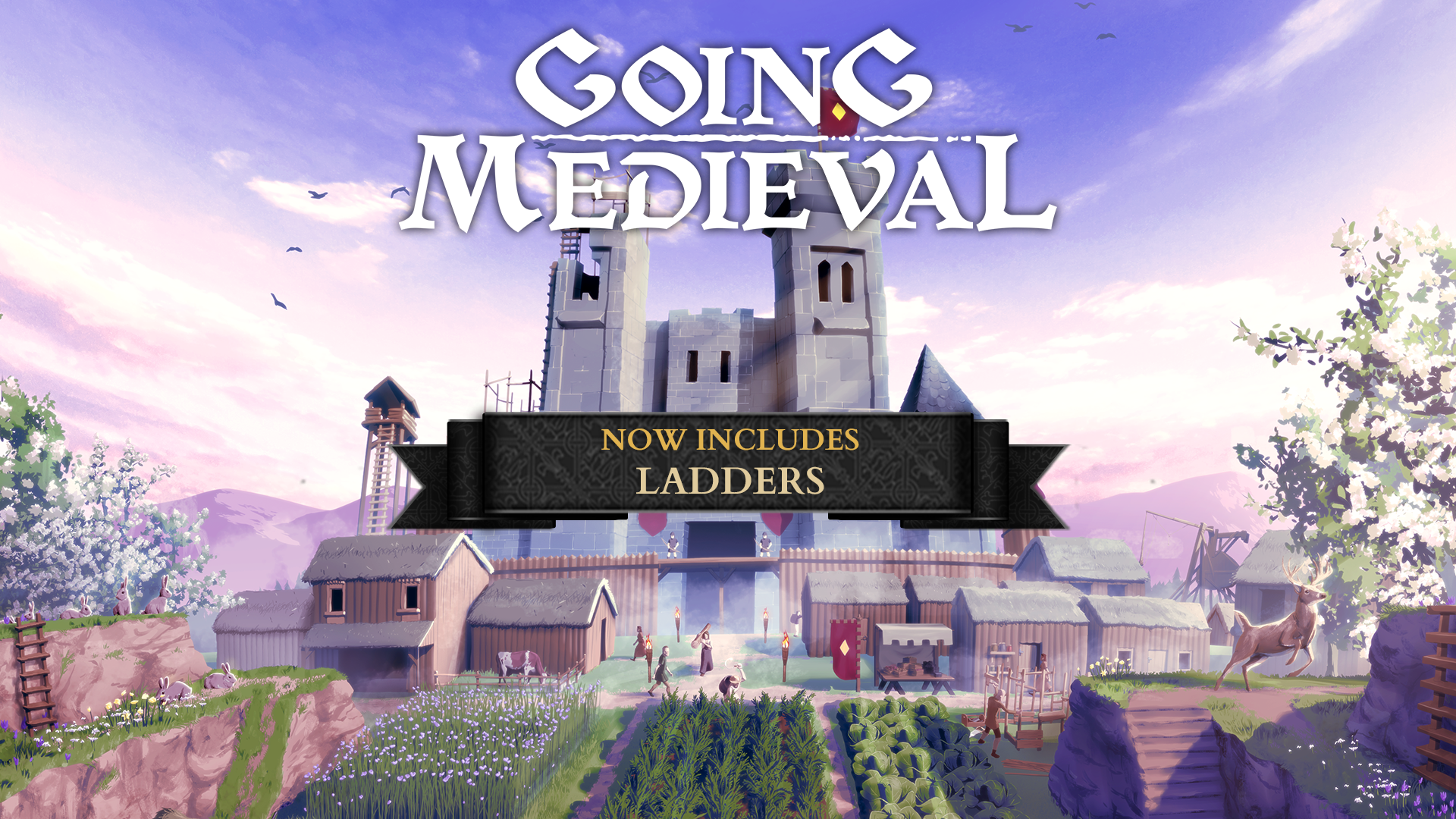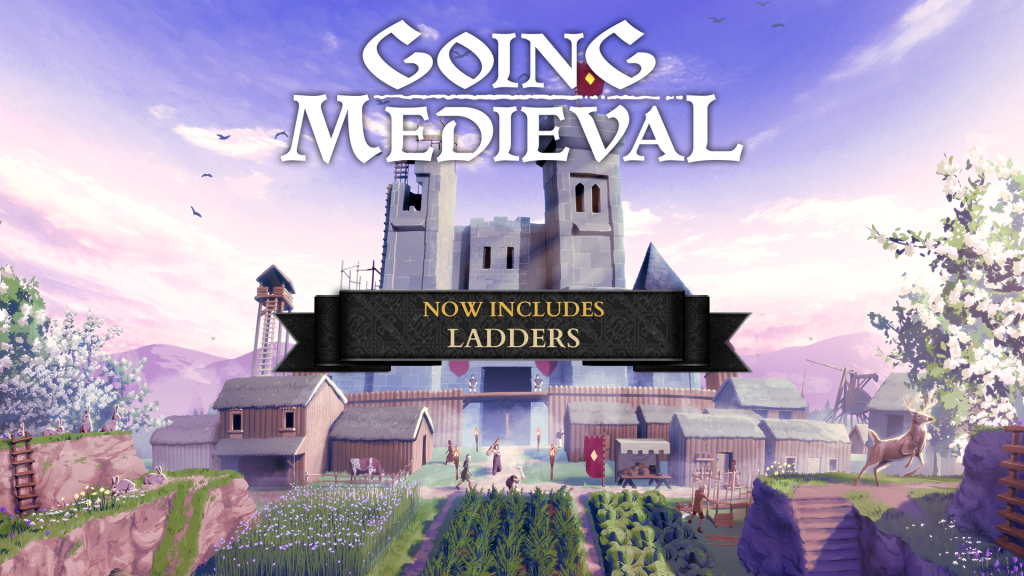Greetings medievalists!
The new major update, titled “Environment Effects Overhaul” is now live on Steam, Epic Games Store, and GOG! It includes: temperature overhaul and its effect on flora, fauna and settlers, ladders, updated environmental effects, and much more!
Watch the video below to see the update’s highlights and if you want to go into more detail, check beneath the video for the full patch notes:
We’ll separate log into different segments:
Temperature Overhaul
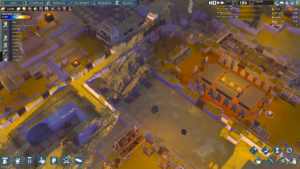
Look at the settlement after toggling Heatmap Overlay
Temperature is calculated a bit more realistically, now. Heat sources will heat up the nodes around them and their distribution allows for a proper flow through open doors and windows and even levels. Temperature spread can be checked via the “Heatmap Overlay” button, located in the upper left corner of the screen. Here’s some noteworthy info:
- Almost everything can be a heat source now – humans, animals, piles, trees, even ground. Some are bigger heat sources than others, and putting them together in a room might lead to maintained warm temperatures.
- Opening doors and windows when it’s cold outside will flow in the cold air.
- Temperature can accumulate over time, so a closed-up room with high insulation will keep getting warmer with time.
- Braziers now have 3 levels of heating (low, medium, and high) which will influence their fuel consumption. The default setting is medium and changing to another level is instant.
- Settlers will not choose idle/eating/sleeping locations that are outside of the comfortable temperature (-8 to 34C).
- Beds located in temperatures outside of the comfortable range will be disabled.
- Map type influences temperature. Mountain maps have colder summers and winters, while valley winters are milder by comparison.
It’s worth mentioning that this also means that ice blocks will never lower the temperature of the storage beyond 0C, no matter how many ice blocks you have. Food will eventually rot, as all food does, but with the proper setup, you can preserve them for a long time.
One of the things that influence the temperature is the sunlight, another factor we’ve worked on.
Sunlight
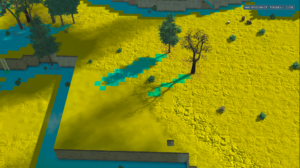
Shadow effect. Healthy tree (left) offers effective shadow, while the dead tree (right) doesn’t
Previously, sunlight was just cosmetic with no effect on the environment. We’ve turned it into an active system that is influenced and influences other features. Notable info:
- Sunlight provides a heating effect.
- Settlers will get heat stroke when in the sun for a long period of time. Having certain apparel, like a wide hat on their head, will help protect them from the heat stroke effect.
- Sunlight’s strength is determined by the angle of the sun.
- Shadows created by sunlight will offer cooler spots.
- During winter, the shadows of dead trees will not affect temperature change.
- Sunlight bouncing off the materials will create diffuse light. This allows for plant growth within inside areas but can also be observed in-game. Speaking of flora growth…
Influence on Plants
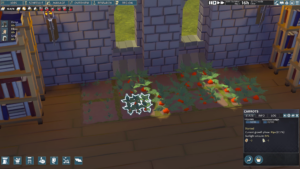
Plants can be grown indoors but may become stunted
Most plants in the early phases need sunlight in order to not grow into stunted versions of those plants. Stunted plants are smaller in appearance and will yield fewer resources. Different flora types have different rules for becoming stunted, but we’ll cover just one here (we’ll leave the rest to you, as a part of the discovery process).
If the cabbage goes from the growing to the grown phase with sunlight accumulation under 50%, it will be stunted. If the sunlight accumulation reaches 0%, the plant will start to lose HP. Sunlight amount represents the number of rays hitting the plant. If that amount is 0%, the plant will grow at 25% of its usual speed. Accumulation influences its health, while amount influences its growth speed.
A tree becomes stunted if it:
- Is surrounded by more than 2 x walls.
- Has more than 2x trees around them (the player needs to sow them row by row in order to make the most out of the tree sowing now.
- Has a roof or floor immediately over it in the layer above.
Here are other important things to know about sunlight’s influence on plants:
- Dead and Mature trees, along with mushrooms, don’t need sunlight to continue growing.
- Plants can be sown under roofs and in caves now.
There is one other change worth mentioning in regard to sunlight, and that is…
Day & Night Cycle
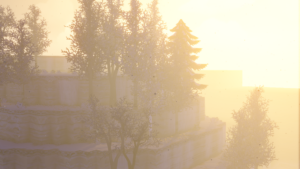
Angle of the sun varies depending on the season now
We’ve mentioned before how we wanted a day and night cycle to somewhat mimic real life when it comes to season changes. Here is some info that might help you along the way:
- In the summertime, the sun will rise around 4 AM and go down around 9 PM.
- During the winter season, sunrise will occur around 8 AM and sunset around 3 PM.
- The angle of the sun is dictated by the seasons.
- The 6th of Winter will be the longest night in the game.
- The 6th of Summer will have the longest day in the game.
If you want more control over the sun’s angle, find MapTypes.json and change the “sunAngle” and “moonAngle” there, along with day and night temperatures. In there, you can also make the map type and enforce the season to your liking (basically, if you want a custom map that only has a summer season with the sun position at 90 degrees, this is where you can do it).
Another neat thing we’ve added are new environmental effects.
Environmental Effects
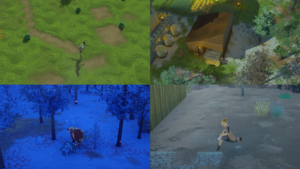
Overall look of the game is improved
Of all the features in Update #9, environmental effects bare minimal consequences on the gameplay. They do, however, make our game super pretty! Just look at the grass – look how rich it looks compared to the old version. But we didn’t stop there. Behold:
- Dirt paths. Walking over the ground frequently will turn it into dirt. Don’t worry, grass grows over time, now. Its speed is influenced by seasons, so it will not grow in winter but during the fall, the growing process will be slowed.
- Rain effectors. These occur if settlers stand in the rain for too long. They’ll get negative effectors and modified comfortable temperatures while in the rain. Standing under a roof will result in them getting dry and losing these effects.
- Wetness. Now, when the rain falls, the ground will accumulate some water that will appear as puddles. This puddle will slowly dry up, and the ground around heat sources will dry up faster. Immersion!
- Snow accumulation. Snow now accumulates while the snow falls. This also means that when settlers and animals walk over snowy areas, they’ll leave trails behind them and snow on the ground will melt. Snow will melt faster in areas with higher temperatures. 80% of its melted parts will turn into wetness. Wetness will not dry up where there is snow over it.
Now it’s the perfect time to mention a new structure type that will handle some of the things mentioned above.
Grated Floors
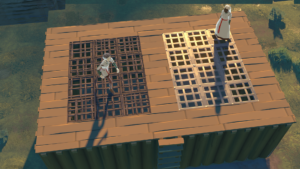
Wicker grated floor (left) and Metal grated floor (right)
We’ve added two new floor types: wicker grated floors and metal grated floors.
- These floors are walkable and behave almost the same as regular floors.
- They let rain and sun through as well as snow.
- They allow for an easier temperature flow from lower levels.
- They keep hail from damaging plants.
- Settlers and enemies can shoot bows and crossbows through them.
And while we’re on the subject of buildings, let’s talk about the thing that will be a game changer for many (according to the discussions here on Steam forums).
Ladders
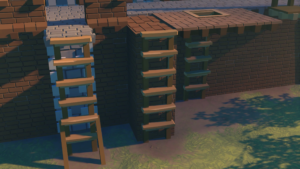
The look of the ladders depending on their constructed position
Ladders are voxel elements (like walls), that allow traversal between two layers. They can be built anywhere (in allowed space), can be stacked up with one another, and can be built adjacent to floors, walls, doors, and windows.
- They are instantly available with no research needed.
- Can’t be placed under beams, floors, walls, and roofs and can’t have beams, floors, roofs, or walls placed over them.
- Can’t be climbed from the “back” side.
- Climbing them results in a slower movement, so when it comes to settlers’ pathfinding, they might look for a longer path for traversal in certain scenarios.
- Cats, polecats, and rats can climb the ladders.
While on ladders, settlers can:
- Deliver resources to blueprints.
- Build.
- Fight.
- Refuel buildings/furniture.
- Pick up/Equip items.
- Lock/unlock doors.
- Open/close windows.
- Take wounded people to bed.
While on ladders, settlers can’t:
- Rope animals if that animal can’t go up the ladders.
Here is what you need to know when it comes to fighting:
- One-handed weapons are 20% slower and their damage is 20% reduced when hitting from ladders.
- Two-handed weapons are 40% slower and their damage is 20% reduced when hitting from ladders.
- Settlers with ranger weapons will switch to melee when on ladders.
- Settlers with shields will put them on their back when climbing ladders.
- Landing a successful critical strike will result in a settler/enemy falling down from ladders.
- Some weapons, like the billhook, have an increased chance of doing critical when the attacker is on a ladder.
Quality of Life Improvements
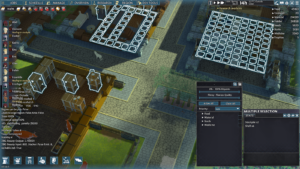
An example of multi-selection and editing in action
- Selecting and editing multiple storage and fuel structures is finally enabled. Keep in mind that the slider and the dropdown menu that appears will always be of the last one selected. The name will appear as “-“ and changing it will give all the structures the same name. Also, the multi-selection will only show common resources/options of those structures.
- Multiple brazier selection will now show the thermal intensity of the last selected brazier (same as in refuel priority).
- The trough is a different structure type now. They work as refillable structures and settlers will refill them if they have under 40% of the food. You can now refill them with a right click.
- Refilling troughs is now considered an animal job, instead of a hauling job like before (because of the bullet point above).
- Settlers will take as many resources as they need to refuel several refillable buildings.
- If a settler starts to construct/farm on a voxel that has a pile on it, that pile would teleport to the free nearby space. Before, settlers would have to do that kind of pile relocation manually which would slow down gameplay and cause some annoyances.
- Animals getting hit have been animated.
- 99% of sounds have been overhauled. Footsteps, animal sounds, and every production will emit sound from time to time. This also applies to UI, environment, and a lot of other things. Listen!
- All items, except the ones acquired from enemies and trade, have “Made by” info.
- Text will pop up if a settler changes status with a different settler, along with the reason why it occurred (eg. When they become rivals, it might say that the reason was an unpleasant conversation). The same principle is applied to the change of religious alignment.
- More text events are added for changing friendships and religious alignment. Here are some actions that might trigger them: Playing backgammon at the same table, eating at the same table, sleeping in the same room, eating/consuming/using a thing someone else made, seeing someone butcher/cook/eat human meat, seeing someone fail at construction/harvest/cutting/mining, seeing someone’s piece of art on the wall, seeing a drunken settle.
- If the following things happen there is a chance that the settler will get a reaction that will change or modify their religious alignment: Losing a friend during a natural event (hailstorm, thunderstorm, blight, heatwave, cold snap), If a settler is drunk, if a raid is won/lost, if a settler makes a flimsy item, if a settler makes a flawless item.
- The decay of certain items has been slowed down. Ice melting and carcass decomposition are slower now.
- Carcasses of wild animals are forbidden by default now if those animals die of old age.
- If a forbidden carcass turns into bones, that bone pile will be forbidden by default.
- Added tooltip info for ice blocks explaining that ice can’t cool down a room under 0C.
- Walls have a grass effect in their base (bottom part) if they are placed on a grassy surface.
- More information has been added to the decomposing/rot and fermenting UI. Those are represented by colored icons and explained a bit more when hovering over them.
- Snow is whiter in appearance.
- Uninstalling constructions and delivering uninstalled piles have a higher priority than delivering resources for construction.
- Animals from merchants will not be targeted by wild animals now.
That would be all for the official update notes. New patches and improvements will be deployed accordingly. In the meantime, feel free to post your experience regarding the new update on Steam discussions. If you want more dynamic/direct communication – head over to our Discord server. Even though we might not reply, we are reading everything. And be sure to…
Stay medieval!
